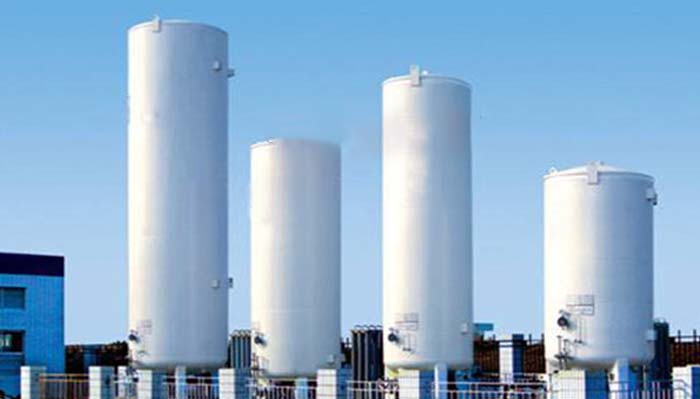Product Category
Requirements for flush irrigation of liquid oxygen storage tank system
Date: Feb 17, 2020

1. The filling coefficient of liquid oxygen cryogenic storage tank shall not exceed 94%;
2. The safety accessories of the liquid oxygen cryogenic storage tank must be complete, sensitive and reliable, and it is forbidden to dismantle, move or stop using without permission; the fire-fighting equipment must be equipped near the liquid oxygen storage tank, and there shall be no inflammable and explosive materials within 4m around the site, so as to keep the site clean;
3. The liquid system shall be provided with liquid oxygen storage tank or fire truck access, and shall be wide enough to facilitate the passage of liquid oxygen storage tank or fire truck;
4. No open fire is allowed within 4m around the storage, gasification, filling and use place of liquid oxygen, no fire source is allowed, and there shall be obvious fire prohibition signs;
5. When liquid oxygen storage tank transports liquid, it is necessary to monitor the reading of pressure gauge frequently, and it is strictly prohibited to exceed the specified value of pressure. When the reading of the pressure gauge increases abnormally, the cryogenic liquid oxygen storage tank shall be opened to the place where people are sparse and open, the vent valve shall be opened, and the pressure shall be discharged. When discharging oxygen, no open fire is allowed in the emission affected area;
6. Liquid oxygen cryogenic storage tank must be equipped with safety valve, liquid level gauge, pressure gauge, static electricity conducting and other safety devices;
7. The liquid oxygen storage tank can only enter the filling place for filling after being approved by the relevant personnel; during filling, the operator must be on site. The tank filling operation shall be carried out in accordance with the operating procedures to prevent the overflow of cryogenic liquid. When the storage tank is filled with liquid oxygen, there shall be no open fire within 4m; 8. The liquid oxygen cryogenic storage tank must be in the braking state to prevent movement before connecting the filling and infusion pipe; anti slip block shall be set at the slope;
8. The liquid oxygen cryogenic storage tank must be in the braking state to prevent movement before connecting the filling and infusion pipe; anti slip block shall be set at the slope;
9. The liquid oxygen storage tank shall leave in time after filling. If the filling work is interrupted for a long time (overnight or holiday interruption), the connection of the infusion pipe shall be released;
10. The engine of the vehicle must be shut down when the liquid oxygen cryogenic storage tank is charged and loaded;
11. The content of acetylene, hydrocarbon, grease and other harmful impurities in the liquid oxygen container and the liquid oxygen storage tank shall be analyzed regularly, and the acetylene content shall not exceed 0.2 × 10-6, otherwise, the liquid oxygen shall be discharged and stopped for heating treatment;
12. Operators shall wear clean leather, canvas or cotton gloves when filling or handling cryogenic liquid. If there is a possibility of liquid eruption or splashing, wear goggles or masks. When dealing with a lot of cryogenic liquid or severe leakage of cryogenic liquid, you should wear leather boots without nails, and the trouser legs are covered outside the leather boots;
13. When filling or disposing liquid oxygen, operators shall not wear greasy work clothes and personal protective equipment. Clothes and protective articles stained with grease shall be replaced; chemical fiber clothes with electrostatic effect shall not be worn; spiked shoes shall not be worn. If the operator's clothing has penetrated with oxygen, it is not allowed to enter the place with open fire. If necessary, it is necessary to replace the clothes or blow off the clothes with sufficient air for at least 11 minutes
2. The safety accessories of the liquid oxygen cryogenic storage tank must be complete, sensitive and reliable, and it is forbidden to dismantle, move or stop using without permission; the fire-fighting equipment must be equipped near the liquid oxygen storage tank, and there shall be no inflammable and explosive materials within 4m around the site, so as to keep the site clean;
3. The liquid system shall be provided with liquid oxygen storage tank or fire truck access, and shall be wide enough to facilitate the passage of liquid oxygen storage tank or fire truck;
4. No open fire is allowed within 4m around the storage, gasification, filling and use place of liquid oxygen, no fire source is allowed, and there shall be obvious fire prohibition signs;
5. When liquid oxygen storage tank transports liquid, it is necessary to monitor the reading of pressure gauge frequently, and it is strictly prohibited to exceed the specified value of pressure. When the reading of the pressure gauge increases abnormally, the cryogenic liquid oxygen storage tank shall be opened to the place where people are sparse and open, the vent valve shall be opened, and the pressure shall be discharged. When discharging oxygen, no open fire is allowed in the emission affected area;
6. Liquid oxygen cryogenic storage tank must be equipped with safety valve, liquid level gauge, pressure gauge, static electricity conducting and other safety devices;
7. The liquid oxygen storage tank can only enter the filling place for filling after being approved by the relevant personnel; during filling, the operator must be on site. The tank filling operation shall be carried out in accordance with the operating procedures to prevent the overflow of cryogenic liquid. When the storage tank is filled with liquid oxygen, there shall be no open fire within 4m;

9. The liquid oxygen storage tank shall leave in time after filling. If the filling work is interrupted for a long time (overnight or holiday interruption), the connection of the infusion pipe shall be released;
10. The engine of the vehicle must be shut down when the liquid oxygen cryogenic storage tank is charged and loaded;
11. The content of acetylene, hydrocarbon, grease and other harmful impurities in the liquid oxygen container and the liquid oxygen storage tank shall be analyzed regularly, and the acetylene content shall not exceed 0.2 × 10-6, otherwise, the liquid oxygen shall be discharged and stopped for heating treatment;
12. Operators shall wear clean leather, canvas or cotton gloves when filling or handling cryogenic liquid. If there is a possibility of liquid eruption or splashing, wear goggles or masks. When dealing with a lot of cryogenic liquid or severe leakage of cryogenic liquid, you should wear leather boots without nails, and the trouser legs are covered outside the leather boots;
13. When filling or disposing liquid oxygen, operators shall not wear greasy work clothes and personal protective equipment. Clothes and protective articles stained with grease shall be replaced; chemical fiber clothes with electrostatic effect shall not be worn; spiked shoes shall not be worn. If the operator's clothing has penetrated with oxygen, it is not allowed to enter the place with open fire. If necessary, it is necessary to replace the clothes or blow off the clothes with sufficient air for at least 11 minutes
Last article:
Next article:
Send Your Inquiry
We not only provide a good product, but also provide high quality service. If you are interested in our products,
you can contact us in the following ways.
you can contact us in the following ways.















































































































